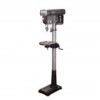Harbor Freight Tools 38144 User Manual - Page 11
Workpiece and Work Area Set Up, General Operating Instructions
 |
View all Harbor Freight Tools 38144 manuals
Add to My Manuals
Save this manual to your list of manuals |
Page 11 highlights
SAFETy SETUp Workpiece and Work Area Set Up 1. Designate a work area that is clean and well-lit. The work area must not allow access by children or pets to prevent distraction and injury. 9. FOR SMALL MATERIALS that cannot be clamped to the table, use a drill press vise. Make sure the vise is clamped or bolted to the table. 2. Route the power cord along a safe route to reach the work area without creating a tripping hazard or exposing the power cord to possible damage. The power cord must reach the work area with enough extra length to allow free movement while working. 3. Secure loose workpieces using a vise or clamps (not included) to prevent movement while working. 4. There must not be objects, such as utility lines, nearby that will present a hazard while working. 5. Make sure the table height and position is set so that the drill travel range is sufficient for the material to be drilled. 10. WHEN DRILLING COMPLETELY THROUGH WOOD, always position a piece of scrap wood between the material and the table to prevent splintering on the underside of the material as the drill breaks through. The scrap piece of wood must make contact with the left side of the column. Securely clamp the other end of the scrap wood to the table. Also, set the depth of the drill so that the drill will not come in contact with the table - or align the table so that the hole in its center is in line with the drill bit. 6. Make sure the work is securely clamped. That is, held in a drill vise, or bolted to the table. Never hold the material with your bare hands while drilling. Severe personal injury may be caused if the material is flung out of the operator's hand. 7. IF THE MATERIAL IS IRREGULARLY SHAPED and cannot be laid flat on the table, it should be securely blocked and clamped. Any tilting, twisting or shifting will result not only in a roughly drilled hole but also increases the chances of damage to the drill. 8. FOR FLAT WORK, lay the piece on to a wooden base and clamp it down firmly against the table to prevent it from turning. Figure D: Bracing workpiece against column General Operating Instructions 1. Bring the drill bit down with the Feed Knob to where the hole is to be drilled. Make minor workpiece alignment adjustments. 2. Plug the Power Cord into an electrical outlet. 3. Turn the Drill Press on. 4. Pull down on the Feed Knob and slowly drill the hole into the workpiece. WARNING! If the drill bit grabs and spins the workpiece, do not attempt to stop the spinning with your hands. Step back, and turn the drill press off. Wait for the spindle to stop turning before dislodging the workpiece. 5. To prevent accidents, turn off the tool and disconnect its power supply after use. Clean, then store the tool indoors out of children's reach. OpERATION MAINTENANcE Item 38144 For technical questions, please call 1-888-866-5797. Page 11















